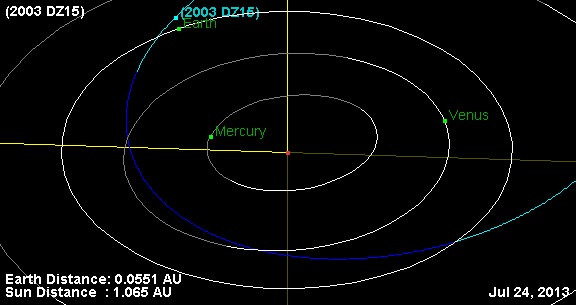The Earth will get another close shave Monday, when the 152 metre asteroid 2003 DZ15 makes a pass by our fair planet on the night of July 29th/30th at 3.5 million kilometres distant. This is over 9 times the Earth-Moon distance and poses no threat to our world.
This is much smaller than 2.75 kilometre 1998 QE2, which sailed by (bad pun intended) our fair world at 5.8 million kilometres distant on May 31st, 2013. The Virtual Telescope Project will be presenting a free online event to monitor the passage of NEA 2003 DZ15 starting Monday night July 29th at 22:00 UT/6:00 PM EDT.
As of this writing, no efforts are currently known of by professional observatories to monitor its passage via radar, though Arecibo may attempt to ping 2003 DZ15 on Thursday.
An Apollo asteroid, 2003 DZ15 was confirmed by the Lowell Observatory and NEAT’s Mount Palomar telescope upon discovery in February 2003. This is its closest approach to the Earth for this century, although it will make a pass nearly as close to the Earth in 2057 on February 12th.
With a perihelion (closest approach to the Sun of) 0.63 A.U.s, 2003 DZ15 can also make close passes by the planet Venus as well, which it last did in 1988 and will do again on 2056.
Closest approach of 2003 DZ15 is set for 00:37 UT July 30th, or 8:37 PM EDT the evening of Monday, July 29th. Although it will only reach about +14th magnitude (based on an absolute magnitude of +22.2), and hence be out of range to all but the very largest Earthbound backyard telescopes, it’ll be fun to watch as it slowly drifts across the starry background live on the internet. Our own, “is worth tracking down from our own backyard” limit is an asteroid passing closer than our Moon, or is farther, but is brighter than +10th magnitude… such are the limitations of humid Florida skies!
Of course, an asteroid the size of 2003 DZ15 would spell a bad day for the Earth, were it headed our way. At an estimated 152 metres in size, 2003 DZ is over seven times the size of the Chelyabinsk meteor that exploded over Russia the day after Valentine ’s on February 15th of this year. While not in the class of an Extinction Level event, 2003 DZ15 would be in 60 to 190 metre size of range of the Tunguska impactor that struck Siberia in 1908.
All enough for us to take notice as 2003 DZ15 whizzes by, at a safe distance this time. NASA plans to launch a crewed mission sometime over the next decade to study an asteroid, and perhaps retrieve a small NEA and place it in orbit about Earth’s Moon. Such efforts may go a long way in understanding and dealing with such potentially hazardous space rocks, when and if the “big one” is discovered heading our way. We’re the Earth’s first line of defense- and unlike the ill-fated dinosaurs, WE’VE got a space program and can do something about it!

